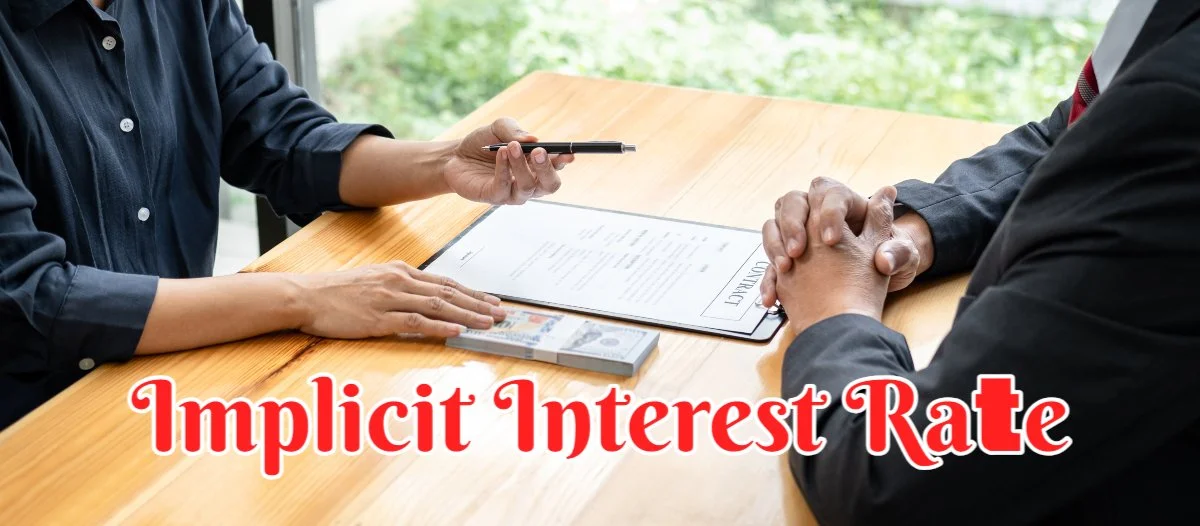It is very important to understand the implicit interest rate in the field of finance. As this unknown factor influences leasing contracts, borrowing choices, and general financial activities. Frequently disregarded or misinterpreted, the implicit interest rate is a significant factor in determining the real cost of loans and the profitability of ventures. In this thorough exploration, we go further into the idea of implicit interest rates, examining their consequences, practical applications, and calculation methods.
What is an Implicit Interest Rate?
An interest rate that isn’t specified in a contract is known as an implicit interest rate. Consequently, the interest rate is inferred rather than stated clearly. Put another way, the implicit interest rate in the tenant’s completed lease is inferred. Here’s an example of an implicit interest rate on a basic loan to help you understand the idea. If you committed to repay a friend $500 in exchange for $600, you have agreed to an implicit interest rate. This is because, even though the interest rate was unclear, you agreed to pay $100 in interest in addition to the $500 principal you borrowed.
A quick calculation will show that you should expect an implicit interest rate of twenty percent. This is so because the $500 principle plus the $100 interest equals 20%. The concept of implicit interest rates has long been known to lease accountants. The interest rate that the lessee pays the lessor during the lease period is typically not included in lease agreements.
The implicit interest rate in a lease is more significant than it has ever been since the implementation of new lease accounting rules like IFRS 16 and ASC 842. In addition to reporting lease obligations and assets on their financial statements, lessees are now required to record a right-of-use (ROU) asset, of which lease interest is one.
Practical Applications and Considerations
There are several uses for the idea of implicit interest rates in a variety of financial sectors and businesses. In the retail industry, for example, the Rooms To Go Credit Card makes it easy for customers to finance furniture purchases with installment plans and deferred interest rates. Through comprehension of the hidden interest rates present in these promotional offerings, customers may make well-informed choices about financing and budgetary techniques.
Implicit interest rates are also significant in investment research and corporate finance. Financial managers have to consider the implicit interest rates in the cash flows resulting from capital budgeting choices like purchases or investment projects. Decision-makers may evaluate the profitability and viability of investment possibilities and deploy capital effectively to maximize shareholder value by discounting future cash flows at the appropriate implicit interest rate.
Calculation of Implicit Interest Rates
This is a simple two-step method for figuring out implicit interest rates:
Total paid / principal borrowed equals X.
X-1 x 100 = implicit interest rates
The preceding example, which involves borrowing $500 from a friend and repaying the loan in full of $600, can be used to demonstrate how the formula functions. Here are the numbers from the example entered into the first step:
$600/$500 = 1.2
Now you know that X here is equals 1.2, by subtracting 1 and multiplying the result by 100, you can calculate the implied interest rate.
1.2 – 1 = 0.2
0.2 x 100 = 20
This sample loan’s implicit interest rate of 20% is confirmed by the calculation. Completing implicit interest rate calculations in the real world involves taking into account other considerations.
The Bottom Line
To sum up, implicit interest rates are a basic idea in finance that influences investment plans, lease terms, and borrowing decisions. People and organizations may more skillfully negotiate the intricacies of financial transactions and make wise financial decisions if they are aware of the implicit interest rate calculation techniques and their importance. An in-depth understanding of implicit interest rates is so important for success in today’s changing economic environment and financial literacy, regardless of whether it’s being used for implicit borrowing rates, implicit rate rates, or implied interest leases in financial markets.
Frequently Asked Questions (FAQs)
Q1: What is the implicit interest rate?
Answer: The beneficial interest rate that is indicated by the terms and conditions of a transaction but is not mentioned in a financial agreement is called the implicit interest rate. When taking into consideration factors like risk concerns, present values, and cash flows, it indicates the real cost of borrowing or the return on investment.
Q2: How to calculate the implicit interest rate?
Answer: The type of financial transaction shows how the implicit interest rate is calculated. For instance, implicit borrowing rates can be computed by taking into account the present value of any future loan-related cash flows, such as interest payments, principal repayments, penalties, or any other costs. In a similar vein, lease agreements compute the implicit rate lease by employing the implicit rate as the discount rate and discounting lease payments to their present value.
Q3: What is the implicit effective interest rate in the agreement?
Answer: The authentic cost of borrowing or the implied return on investment determined by the terms and circumstances of the financial arrangement is referred to as the effective rate of interest implicit in the agreement. It displays the real interest rate used to compare the present value of the transaction’s cash inflows and outflows.
Q4. What is the difference between implied and implicit interest rates?
Answer: The settings in which implied and implicit interest rates are used determine the primary distinction between them. Generally speaking, implicit interest rates are the effective interest rates that are included in certain financial transactions, such as leases or borrowing arrangements. Implied interest rates, on the other hand, are based on the market values of financial instruments, including bonds and options, and they represent predictions about future changes in interest rates, inflation patterns, and risk premiums.
Q5. How accurate are implicit and implied interest rates?
Answer: Implicit and implicit interest rate accuracy is dependent upon several criteria, such as the validity of the data used as input, the suitability of the mathematical models or techniques employed in the computation, and the analysis’s underlying assumptions. Implicit interest rates obtained from market prices are susceptible to market volatility, liquidity circumstances, and investor mood, but implicit interest rates generated from real financial transactions offer a more realistic assessment of the cost of borrowing or the return on investment. Because of this, it’s crucial to evaluate implicit and implied interest rates in combination with other financial indicators and keep in mind the risks and uncertainties that come with doing financial research and making decisions.
Also Read:
- Best Credit Building Apps You Can’t Miss: Secure Your Financial Future
- Payment Cloud: A Comprehensive Guide to Streamlining Your Finances
- Track Your Spending And Reach Your Financial Goals: The Top Personal Finance Apps To Try




